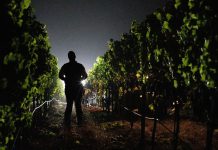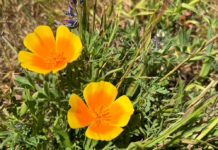Mary Kelley
The earthquake in northeast Japan was reported as an 8.9, and it
lasted five minutes. It was 1,000 times greater than the magnitude
of the 6.9 Loma Prieta earthquake of 1989, and last year’s 7.0
earthquake in Haiti. Yet relatively few lives were lost; Japan has
learned to be prepared for the earth quaking.
With the recent earthquake on my mind, I keep hearing my dad
calling to his children across the house: “Brace yourselves kids,
Mother Nature is speaking.” He would sense the movement of the
earth in his feet, well before we felt the jolts. We were trained
to move calmly toward door jams, away from windows, and, because we
lived 180 feet below sea level and the Colorado River water held
behind Hoover Dam, we were always ready to grab the hibachi and
drive above the ancient beach line rimming our valley as soon as
the earth stopped her adjustments.
This earthquake has realigned my thoughts, my focus, my purpose,
to that of Food Security. The nightmares I used to have about being
flooded, I now see in the images from the tsunami in Japan. My
prayers go out to those whose lives have been damaged by the
earthquakes.
I am also reminded of the apple farmer who sat next to me at the
California Small Farm Conference last week. The spunky, 70
something farmer spoke a language that was so much like my
father’s; I never heard him say a cross word about the rain, or the
wind, or the heat, or the frost, or the earthquakes. Nature was to
be understood and respected.
“We have to learn to stop fighting nature, and dance with her.
And we had better let her take the lead,” my new acquaintance told
me. When I asked Alison Law-Mathisen about her third generation
apple farm, we learned that we both have oak trees surrounding our
apple trees. “Do you have codling moths? I asked. She explained
that the codling moth lays its eggs in the acorns as well as the
fruit in the orchard.
“Do you have woodpeckers at your place? she asked. I responded
with an enthusiastic yes. “We have acorn woodpeckers and
red-shafted flickers, but they are at war with the starlings, which
steal their nesting cavities.”
Alison picked up the card from the dinner table with the word
“Vegetarian” printed on one side, and “Meat Dish” printed on the
other, which we were using to display our preference for the meal.
“Do you think woodpeckers are vegetarians or carnivores?” I thought
about that for a minute.
“Protect those woodpeckers,” she advised, “because they are
carnivores and they will feast on the larvae of the codling moth.
Notice how many acorns are placed on the south side of the trees.
Watch. The warmth of the sun hatches the eggs, and the woodpeckers
listen for the movement of the hatching larvae. Then they reach in
to eat those worms.”
Most people would have just cut down the oak trees, I tell her.
She reminds me again that, “Life is a dance with Mother Nature.”
She told me how her father would take an inventory of moths
attracted to the porch light at night. When he saw a rise in
codling moths, and then a decline marking the end of one hatch,
then he knew the next hatch would occur at a certain date. In this
way he could time his treatment properly. What did they spray? A
mixture of tobacco, cayenne, and other organic ingredients.
My new friend told me that her 93 year old mother has been going
to the Beatrix Potter Convention in the Lake District of England
for over 30 years, and lately Alison has accompanied her.
A piece in American Scientist magazine reminded me that Beatrix
Potter was devoted to conservation of the natural world as well as
the traditional culture of farming, as it was practiced before
fossil fuels.
“Helen Beatrix Potter (1866-1943) secured a place among the
immortals of English literature with her books for children,
starting with The Tale of Peter Rabbit (1902). Less well known is
the fact that she was also a major conservationist who devoted the
latter part of her life, and all of her fortune, to preserving the
landscapes and farming practices of the Lake District in northwest
England. By the time of her death, she had written and illustrated
33 books and amassed over 4,000 acres of crucial hill-farm
property. She bequeathed the land to the nation via the National
Trust for Places of Historic Interest or Natural Beauty, an
institution her father helped found.”
The land is leased to 14 farmers, who have agreed to adhere to
traditional farming methods, to dance with Mother Nature, and to
let her take the lead.
Mary Kelley is the manager of the Healdsburg Farmers’ Market.
The market is dormant for the winter.








